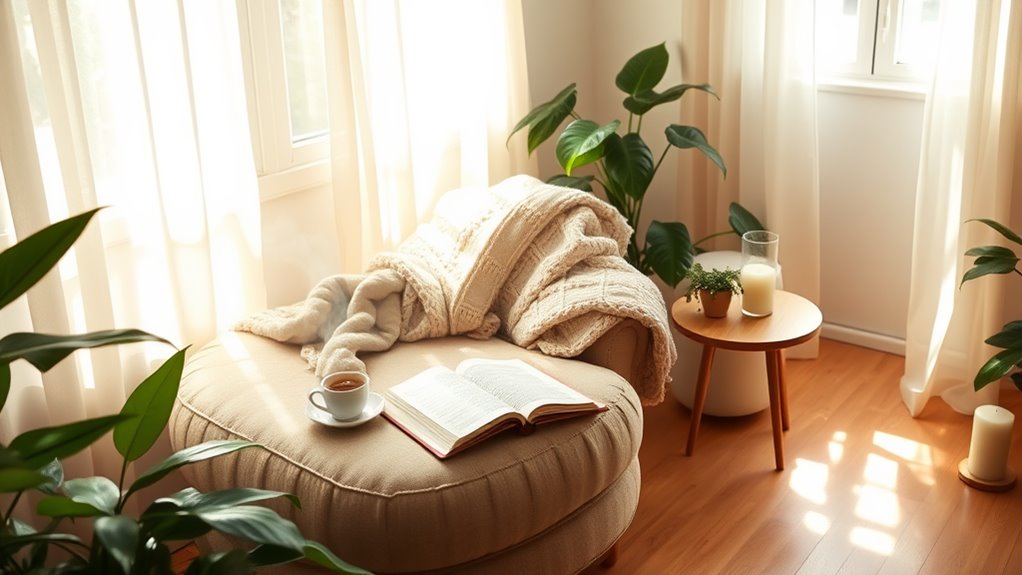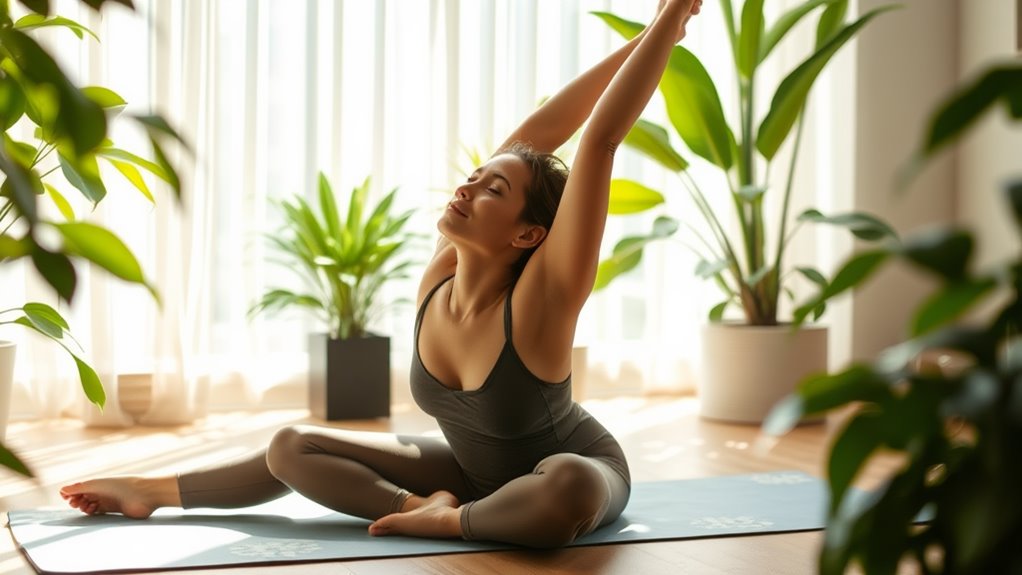I Use This Relaxing Routine When I Need to De-Stress
When you need to de-stress, creating the right environment is key. Start with soft lighting and a few plants to foster tranquility. Incorporate breathing exercises, like inhaling for four counts, to ground yourself. Journaling helps you process emotions and clarify thoughts. Don’t forget warm baths to soothe sore muscles and improve sleep. Setting tech-free times allows you to be present. These small shifts can significantly enhance your relaxation routine, and there’s much more you can explore.
Key Takeaways
- Start with deep breathing exercises, inhaling for four counts, holding for four, and exhaling for six to promote relaxation.
- Create a calming environment by decluttering your space and using soft, warm lighting to enhance comfort.
- Incorporate essential oils like lavender or chamomile in a diffuser to soothe your mind and body.
- Engage in a creative hobby or journaling to process emotions and reduce stress through self-expression.
- Dedicate time to disconnect from technology, practicing mindfulness or enjoying nature to refresh your mental well-being.
Understanding the Importance of De-Stressing
When you’re constantly juggling responsibilities, it’s easy to overlook the importance of de-stressing. You might think you don’t have time for self-care, but prioritizing your mental well-being is crucial.
De-stressing isn’t just a luxury; it’s a necessity for maintaining focus, creativity, and overall health. When you take a moment to breathe, meditate, or engage in a calming activity, you’re investing in your ability to handle life’s pressures. Incorporating simple stretches for stress relief can also enhance your relaxation experience.
It’s about finding what works for you—whether it’s a short walk, reading a book, or practicing mindfulness. Remember, self-care doesn’t have to be time-consuming; even small, intentional acts can make a significant difference.
Embrace de-stressing as a vital part of your routine, and you’ll feel more balanced and energized.
Setting the Right Environment
Creating the right environment is essential for effective de-stressing, and even small changes can make a big difference.
By optimizing your surroundings, you can foster a sense of calm and relaxation. Here are three practical tips to consider:
-
Declutter Your Space: A tidy area can significantly reduce mental clutter, allowing you to focus on relaxation.
-
Adjust Lighting: Soft, warm lighting can create a cozy atmosphere. Use lamps or candles instead of harsh overhead lights.
-
Incorporate Nature: Adding plants or natural elements brings a soothing vibe, reminding you of the outdoors and promoting tranquility. Additionally, engaging with natural elements can enhance your overall well-being and mindfulness.
Breathing Exercises for Calm
Once you’ve set a calming environment, the next step is to focus on your breath.
Start by finding a comfortable seated position, allowing your shoulders to drop and your hands to rest gently. Inhale deeply through your nose for a count of four, feeling your abdomen expand. Hold that breath for a count of four, and then exhale slowly through your mouth for a count of six.
Repeat this cycle several times, letting each breath draw you deeper into relaxation. If your mind wanders, gently guide it back to your breath.
This simple breathing exercise can help ground you and reduce stress, reminding you that calm is just a few breaths away. In fact, incorporating mindful relaxation into your routine can significantly enhance your overall well-being. You deserve this moment of peace.
Mindful Meditation Techniques
Although it might seem challenging at first, incorporating mindful meditation techniques into your routine can be a powerful way to de-stress. These practices allow you to cultivate awareness, helping you stay present and calm amidst life’s chaos. In fact, making these techniques a part of your self-care rituals can significantly enhance your overall well-being.
Here are three effective techniques to get you started:
-
Body Scan: Focus on each part of your body, noticing tension and releasing it, which fosters relaxation.
-
Guided Imagery: Visualize a peaceful place, immersing yourself in the sights and sounds to soothe your mind.
-
Breath Awareness: Pay attention to your breathing, allowing distractions to fade while you center your thoughts.
Gentle Stretching and Yoga
After practicing mindful meditation techniques, you might find that incorporating gentle stretching and yoga can further enhance your relaxation and well-being.
These practices help release tension in your body, improve flexibility, and promote a sense of calm. Start with simple poses, like Child’s Pose or Cat-Cow, to gently ease into movement.
Focus on your breath, letting it guide your stretches. Even just 10 minutes can make a difference.
Remember, it’s not about perfecting each pose; it’s about tuning into your body and what feels good. You’ll notice that connecting breath with movement helps clear your mind, allowing you to unwind.
Engaging in a Creative Hobby
Engaging in a creative hobby can be a powerful way to reduce stress and bring joy into your life.
Whether it’s painting, writing, or crafting, these activities can help you express yourself and discover your passions.
Let’s explore the benefits of creative hobbies and some practical tips to get you started.
Benefits of Creative Hobbies
Creativity can be a powerful antidote to stress, offering not just an escape but also a pathway to personal growth. Engaging in a creative hobby can enhance your well-being in several ways:
-
Reduces Stress: Focusing on a creative activity can divert your mind from daily pressures, allowing you to relax and recharge.
-
Boosts Confidence: Completing a project or mastering a new skill can foster a sense of accomplishment, improving your self-esteem.
-
Enhances Problem-Solving Skills: Creativity encourages you to think outside the box and approach challenges from different angles, which can benefit other areas of your life.
Finding Your Passion
How can you discover a creative hobby that truly resonates with you? Start by exploring various activities that spark your interest. Consider what excites you, whether it’s painting, writing, or playing a musical instrument. To help you narrow down your choices, here’s a simple table to guide you:
| Activity Type | Emotional Response |
|---|---|
| Visual Arts | Inspiring and Relaxing |
| Performing Arts | Energizing and Joyful |
| Crafts | Fulfilling and Therapeutic |
Reflect on how each activity makes you feel. Don’t hesitate to try something new; sometimes, the best passions emerge unexpectedly. Engaging in a creative hobby can be an enriching journey, so be patient and give yourself the space to explore.
Tips for Getting Started
Although starting a new hobby can feel overwhelming, breaking it down into manageable steps can make the process enjoyable. Here are three tips to help you get started:
-
Choose a hobby that excites you: Think about what interests you the most. Whether it’s painting, writing, or gardening, find something that sparks joy.
-
Set realistic goals: Start small. Instead of aiming for perfection, focus on simply enjoying the process. Set achievable milestones to help you stay motivated.
-
Schedule time for your hobby: Treat it like an appointment. Carving out dedicated time in your week ensures you prioritize this relaxing activity.
Nature Walks and Their Benefits
When you step into nature for a walk, you’re not just enjoying the scenery; you’re also providing your mind and body with a much-needed break from everyday stressors.
Nature walks can lower your stress levels, boost your mood, and improve your overall well-being. The fresh air and natural surroundings stimulate your senses, helping to clear your mind and enhance your focus.
Plus, the rhythmic movement of walking can promote relaxation and mindfulness. You don’t need to hike for miles; even a short stroll in a nearby park can be beneficial.
Aromatherapy for Relaxation
Aromatherapy can be a powerful tool for relaxation, and choosing the right essential oils is key to enhancing your mood.
Whether you prefer soothing lavender or uplifting citrus, knowing how to effectively diffuse these oils can make all the difference.
Let’s explore some practical techniques to incorporate aromatherapy into your de-stressing routine.
Essential Oils Selection
Choosing the right essential oils can make a significant difference in your relaxation routine, as each oil carries unique properties that can soothe both the mind and body.
Here are three essential oils you might consider incorporating:
-
Lavender: Known for its calming effects, lavender is perfect for reducing anxiety and promoting a restful sleep.
-
Bergamot: This citrus oil lifts your mood and helps alleviate stress, making it a great addition for emotional balance.
-
Chamomile: With its gentle sedative properties, chamomile can help ease tension and create a sense of peace.
Diffusion Techniques Explained
While you may already have your favorite essential oils, knowing how to effectively diffuse them can enhance your relaxation experience.
There are several diffusion techniques you can try. An essential oil diffuser is a popular choice, dispersing oils into the air with a gentle mist. If you don’t have one, you can also use a bowl of hot water—just add a few drops of your chosen oil and breathe deeply.
Another method is to put a few drops on a cotton ball and place it near your workspace or bedside. Whichever method you choose, remember to start with a small amount of oil, as less can often be more when it comes to creating a calming atmosphere.
Journaling to Process Emotions
Many people find journaling to be a powerful tool for processing emotions. It allows you to express your feelings freely, helping to clarify thoughts and gain perspective.
Here are three ways journaling can benefit you:
-
Emotional Release: Writing down your feelings can relieve stress and anxiety, acting as a safe space to vent.
-
Self-Reflection: Journaling encourages you to look deeper into your emotions, helping you understand patterns and triggers.
-
Problem-Solving: By articulating your challenges on paper, you may discover new solutions or ways to cope.
Try setting aside a few minutes each day to write.
You’ll likely find it’s a simple yet effective way to navigate your emotional landscape and feel more centered.
Warm Baths and Relaxation
Taking a warm bath can be a simple yet effective way to unwind and de-stress after a long day.
The soothing heat relaxes your muscles and promotes a sense of calm, making it an ideal addition to your relaxation routine.
To enhance the experience, consider adding elements like calming scents or soft music to create a more tranquil atmosphere.
Benefits of Warm Baths
Imagine sinking into a warm bath after a long, stressful day. The soothing warmth envelops you, offering not just comfort but a range of benefits that can help ease your mind and body.
Here are three key advantages of indulging in a warm bath:
-
Muscle Relaxation: The heat helps to relieve tension in your muscles, easing soreness and promoting relaxation.
-
Improved Sleep: A warm bath can raise your body temperature, and as it cools down afterward, it signals your body that it’s time to sleep.
-
Stress Relief: Immersing yourself in warm water can lower cortisol levels, helping you to unwind and reduce anxiety.
Incorporating warm baths into your routine can be a simple yet effective way to find tranquility amidst life’s chaos.
Adding Relaxing Elements
When you prioritize self-care, adding relaxing elements like warm baths can significantly enhance your overall well-being. A warm bath not only soothes your muscles but also calms your mind.
Consider adding Epsom salts for extra relaxation or essential oils like lavender for an aromatic experience.
To create a tranquil atmosphere, dim the lights and play soft music or nature sounds. You might also want to bring a good book or a magazine to enjoy while you soak.
Remember to make this a regular practice, carving out time just for yourself. Even 20 minutes can make a difference.
Disconnecting From Technology
In today’s fast-paced world, many people find themselves constantly tethered to their devices, often leading to increased stress and anxiety.
Taking a break from technology can be a game changer for your mental well-being. Here are three simple ways to disconnect:
-
Set Specific Tech-Free Times: Designate certain hours in your day to unplug, allowing yourself to be present in the moment.
-
Engage in Outdoor Activities: Spend time in nature without your phone. It can refresh your mind and boost your mood.
-
Practice Mindfulness: Use your tech-free time to meditate or journal, helping you reconnect with your thoughts and feelings.
Establishing a Nighttime Routine
Creating a consistent nighttime routine can significantly enhance your ability to unwind and prepare for restful sleep. Start by setting a regular bedtime, aiming to go to sleep and wake up at the same time each day.
Incorporate calming activities like reading, gentle stretching, or practicing mindfulness to signal your body that it’s time to relax. Dim the lights and consider using soothing scents, like lavender, to create a tranquil atmosphere.
Avoid screens at least an hour before bed to reduce blue light exposure. Finally, take a few moments for deep breathing or gratitude reflection, easing your mind of the day’s worries.




